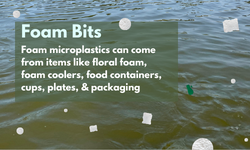 Microplastics are plastics that are less than 5 mm in size and a lot about them is unknown. Research has shown that microplastics can cause physical harm to wildlife when ingested. Microplastics can absorb other chemicals such as trace metals, polycyclic aromatic hydrocarbons, pesticides, and some pathogens. Initial research has also suggested that plastic additives can contribute to disruption in the endocrine system and possibly cancer. Currently, there are five types categorized by the USGS: fibers, foam, fragments, beads/pellets, and film. After a study of microplastics in the Great Lakes Region published in 2016 from USGS, they found that foam microplastics were present in Maumee and Portage Rivers.
Microplastics are plastics that are less than 5 mm in size and a lot about them is unknown. Research has shown that microplastics can cause physical harm to wildlife when ingested. Microplastics can absorb other chemicals such as trace metals, polycyclic aromatic hydrocarbons, pesticides, and some pathogens. Initial research has also suggested that plastic additives can contribute to disruption in the endocrine system and possibly cancer. Currently, there are five types categorized by the USGS: fibers, foam, fragments, beads/pellets, and film. After a study of microplastics in the Great Lakes Region published in 2016 from USGS, they found that foam microplastics were present in Maumee and Portage Rivers.
Foams are considered to be expanded polystyrene foam- meaning it is a plastic in a fluffy form, polystyrene can be solid like a water bottle or expanded in foam form. Foam can be items like Floral foam, foam coolers, food containers, cups, plates, and packaging can contribute to this kind of microplastic in our waterways. Reducing or refusing foams are a primary way to reduce foams from ending up in our waterways.
We are proud partners on the Trash Trappers for a Cleaner Toledo Project for Trash Free Waters Toledo. Toledo is installing trash trappers to take care of the microplastics and plastic marine debris before it becomes microplastics in the water while we help remove the marine debris on land before it enters our waterways.
